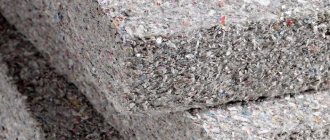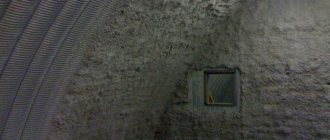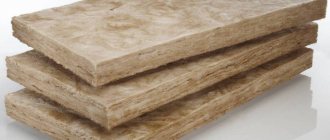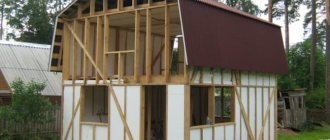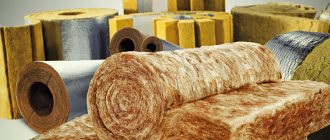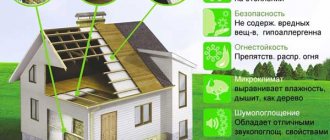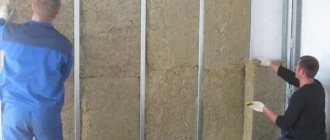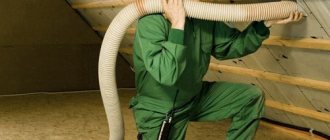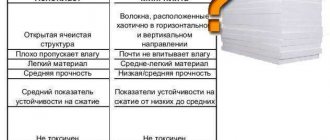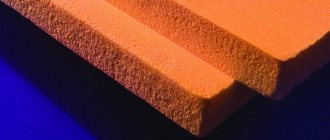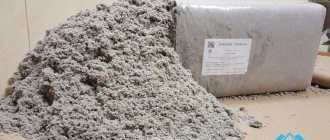If you are planning to build a house for yourself and are choosing insulation, then this article is especially for you. In this article we will introduce you to the insulation material - Ecowool.
In the photo there is a 15kg Ecowool briquette (Donskaya Ecowool, Tula)
In the photo there is a 15kg Ecowool briquette (Donskaya Ecowool, Tula)
Table of contents:
- A little history
- Ecowool composition
- What is Borax
- Boric acid
- Ecowool insulation cost
- Thermal conductivity Ecowool
- Air permeability Ecowool
- Energy efficiency Ecowool
- Capillary activity of Ecowool
- Fire safety Ecowool
- Environmental friendliness Ecowool
- Rodents and mice in Ecowool
- Ecowool - antiseptic
- Noise insulation Ecowool
- Heat capacity of ecowool
- Ecowool shrinkage
The history of ecowool
Ecowool is the Russian name for cellulose insulation. In world practice it is called “Cellulose Insulation”. Ecowool appeared in Russia in 1993, but in world practice it became known already at the beginning of the last century. In 1928, the first production of this insulation was created in Germany. Today, this insulation is well known and popular in many countries around the world. This insulation is especially popular in countries located in northern latitudes, in the humid climate zone:
- Finland
- Sweden
- Norway
- Germany
- Canada
- USA and other countries
According to the Russian information portal Wikipedia, in Finland, cellulose insulation accounts for up to 70% of the total market for insulation used in individual housing construction.
What does this insulation consist of?
Ecowool 81 % recycled cellulose (newsprint paper), 7 % of Borax anti-friction agents (flame protection) and 12 % of natural antiseptics Boric acid (protection from rodents, mold, insects)
Ecowool composition
This is what ecowool looks like up close, it is a fibrous crushed material, gray in color, some inclusions may be present in the form of scraps of newspaper waste paper, sometimes you can even make out the text.
Fiber structure Ecowool
It has no smell and does not generate dust. Ecowool can be compressed, it takes a fixed shape, this can be used, for example, when installing this insulation into small cracks yourself. In addition, there is no need to fear that it will fall out of the holes through which it was mounted. It holds its shape and will not fall out anywhere.
Is it possible to make high-quality insulation with your own hands?
Building materials are becoming more and more expensive every day. In this regard, the question is increasingly being asked: is it possible to make insulation with your own hands? Fortunately for many ordinary people, this is a completely solvable task, and the final result will be very productive. Next we will consider the two most interesting methods.
A proven "old fashioned" method - sawdust
The entire post-Soviet space is rich in luxurious forests. Therefore, since ancient times, sawdust has been actively used in various fields of construction, in particular as insulation. Another reason for the popularity of this natural raw material is the ability to give it any condition with your own hands.
To use sawdust as insulation, it must be prepared in a certain way. Otherwise, they will rot after the first winter, and you will have to redo all the rather labor-intensive work. You will need to create the so-called “sawdust blocks” with your own hands. This procedure is performed in the following sequence:
- The quality of sawdust is assessed. In particular, they must be without impurities and have approximately the same fraction. If any foreign debris or impurities are observed, the mass will have to be cleaned.
Advice: you should not use “fresh” sawdust, that is, which has recently been used up. The ideal option is when they are about a year old, in which case they are more pliable.
- The starting material must be well dried. Ideally, scatter it in a sunny attic. If you do not have a large room, you can use convectors.
- When the raw materials are completely dry (this can be determined by touch), large containers of at least 100 liters are prepared. Next, the mixture is mixed in the following proportion: 10 buckets of sawdust x 1 sand (necessarily cleared of foreign impurities) x 0.5 cement (the stronger the brand, the better).
- The resulting powder mass is filled with a solution of boric acid. Boron itself can be bought at any pharmacy or chemical store, and it is quite inexpensive. If you do not use this solution, then after the first freezing the insulation will turn black and lose its quality. In addition, it will provide moisture resistance.
- This mixture is then thoroughly mixed. Doing this with your own hands will be extremely problematic, so it is better to use a drill with an appropriate attachment. The resulting composition is poured onto the floor (or ceiling) between the joists.
The resulting thick mass will become a solid and monolithic material, but this will take a lot of time - from 2 to 4 months. Therefore, it is best to carry out such work in the spring or early summer, so that the insulation has time to acquire the qualities it needs before the onset of cold weather.
Another eco-friendly material is waste paper.
The above technology is relevant only for insulating the floor or ceiling, but what to do with the walls? There is another cheap (or practically free) raw material from which you can make a good heat insulator - waste paper. This insulation is also made as simply as possible:
- Absolutely any waste paper (in other words, unnecessary paper) is taken. The required quantity is almost impossible to predict, as it will depend on many factors.
Advice: it is best to use low-grade waste paper, as it has better properties necessary for protection from the cold.
- A container of at least 100 liters in volume is prepared. Then carefully shred the paper to a fraction no larger than 1×1 cm. Manually this work will take quite a lot of time, so it is ideal to use a shredder or extruder.
- The crushed mass is placed in a container and filled with water at the rate of 20 liters of water per 1 kg of raw material. The solution is thoroughly mixed. You can do this manually, using, for example, a shovel, but it will take a very long time. Therefore, it is recommended to use a drill with an appropriate attachment.
- Then you need to add hydrophobic agents (any of your choice) to the resulting composition. They will protect the material from moisture. It is also necessary to use an antiseptic (it will protect against fungi and mildew) and soda ash (it will increase fire resistance). Soda consumption: 100 g per 200 kg of finished mixture. The resulting mass is left for 3-4 days to “set.”
- After waiting for the composition to be “cooked,” you need to mix it (with the same drill) and pour it into the mold for pouring. It can also be made from any available materials, the main thing is that a fine mesh serves as the bottom. The thick mixture is placed in a mold and left for 3-7 days (depending on the weather). At the end of this period, it will turn into a monolithic insulation in the form of a slab. You can use it to decorate walls by placing it on any glue, because the weight of the material will be quite small.
We recommend: Insulating walls from the outside: types of external insulation for a brick or concrete building, density of slabs and rating of materials
The nuances of using such technologies
Anyone who decides to make insulation with their own hands should know several important features of such techniques:
- The resulting heat insulators are not relevant for cold regions. Unfortunately, this technology is not very effective. Therefore, it can only be used in temperate climates. To organize an effective thermal insulation layer in the northern regions, it will have to be very thick (50-100 cm), which is not entirely rational.
- Materials made from environmentally friendly materials (especially sawdust and waste paper) are not durable. Despite the use of various additives, they begin to rot over time. Therefore, you need to be prepared for the fact that you will have to regularly (on average once every 4-5 years) “reboot” the thermal insulation layer.
- This technology also has one important advantage - the insulation materials made by yourself are absolutely environmentally friendly. In this aspect, they clearly outperform penoplex and mineral wool, which are popular today.
- Natural origin attracts various insects and rodents. Therefore, the use of such materials requires the creation of additional protection against such factors (repellents, traps, etc.).
Same composition in all countries
I would like to especially draw your attention to the fact that despite the wide geography of application of this insulation, in almost all countries, including Russia, the manufacturing technology of this material, its composition, are almost the same - it includes three components: this is cellulose - newspaper waste paper, this is borax and boric acid .
If everything about waste paper is very clear, then about borax and boric acid, not so much. Let's look at them in more detail:
Self-production of cellulose boards
Is it possible to make more convenient paper insulation with your own hands?
Yes, you can make some kind of thin and dense insulation from waste paper. Whether the result is worth your time is debatable; however it is possible.
Here is a description of the production process.
- The paper is shredded and poured into a barrel. The smaller the fragments, the better the result. Then it is soaked for a day or two. Water should completely fill the paper.
- After this time, water is added to the barrel at the rate of 20 liters per kilogram of waste paper.
- An oil emulsion is made in a separate container: 100 grams of machine oil and water are taken per 200-liter barrel. The mixture is whipped with a mixer and added to the barrel: it will make the material hydrophobic.
- Add 100 grams of soda ash to the barrel (it will reduce the ability of the insulation to ignite) and 20 grams of boric acid (an antiseptic).
- Beat the mixture thoroughly. This can be done with an improvised mixer: three pieces of 4 mm wire are clamped into the drill chuck; then the last 15 centimeters of each segment are bent radially.
- After 5-7 days of settling, the mixture is whipped again. It should become as homogeneous as possible: in this case, the density of the insulation will be minimal, and the yield of useful volume will be maximum.
- We are constructing a mold for the future insulation board. Overall dimensions are arbitrary (you can focus on 50x100 centimeters). The bottom is a mesh on a solid base that allows water to pass through, or simply polyethylene pierced in several places with an awl and laid out on flat sand.
So, what is Borax?
Sodium tetraborate (“borax”, “borax” (from Latin borax
)) is an inorganic compound, sodium salt of boric acid with the chemical formula Na2B4O7, the most common and used boron compound, forms several crystalline hydrates, and is widely used in industry.
In the photo "Bura"
Sodium tetraborate (Borax) is used:
- as a raw material for the production of boric acid and various boron compounds
- in the production of enamels, glazes, optical and colored glasses, various ceramics
- when soldering and melting metals in flux
- in the paper and pharmaceutical industries
- in the production of building materials as an antiseptic component for the production of cellulose insulation ecowool
- as a disinfectant and preservative
- for preparing buffer solutions
- in analytical chemistry (as a standard substance for determining the concentration of acid solutions)
- for qualitative determination of metal oxides (by pearl color)
- in photography - in slow-acting developers as a weak accelerating agent
- as a component of detergents
- as a component of cosmetics
Boric acid
Boric acid (orthoboric acid or lat. acidum Boricum) is a weak, monobasic Lewis acid, often used as an insecticide, antiseptic, and fire retardant.
In the photo "Boric acid"
Application
- Boron fertilizer
- Used in laboratories to prepare buffer solutions
- In medicine - as an independent disinfectant for adults, and also in the form of a 2% solution - for washing the skin after contact with alkalis
- Also, various combination preparations are produced based on boric acid (ATX group D08AD), for example Teymurov’s paste
- Registered in the food industry as food additive E284
- In jewelry - as the basis of fluxes for soldering gold-containing alloys
- In everyday life - extermination of cockroaches, ants, bedbugs
- In the production of ceramics, fiber optics, fiberglass, glass
- As a fire retardant to protect wood
- As part of electrolytes for copper and nickel plating
Cost of insulation - Ecowool
For correct calculation, let's take the insulation thickness of 100 mm. The price will include all work and the material itself.
Horizontal surface - 190 R/m2
Sloping and vertical surfaces from 240 R to 350 R/m2
The approximate cost of insulating a house with a total area of 120-150 m2 on a turnkey basis (thermal circuit) ranges from 100 to 200 thousand rubles. The price is comparable to all types of insulation with basalt or mineral slabs.
Insulation calculator
Ecowool calculation calculator
Thermal conductivity Ecowool
Thermal conductivity is the ability of material bodies to conduct energy (heat) from more heated parts of the body to less heated parts of the body through the chaotic movement of body particles (atoms, molecules, electrons, etc.).
The thermal conductivity coefficient of ecowool is 0.039 (W/m*K)
For understanding, below are data on the most common types of insulation.
Thermal conductivity table
The table shows that the thermal conductivity coefficient of ecowool is higher than the average result.
Air permeability of ecowool
Thanks to the technology of seamless application and the dense fibrous structure of the material, ecowool has low air permeability. The absence of joints and cracks determines the future tightness of the entire building.
A house insulated with cellulose fiber is 40% more energy efficient
There is a video on the Internet devoted to a comparative analysis of this “tightness” parameter. In America, they took two houses, identical in design, one house was insulated with mineral wool, the second house was insulated with cellulose insulation. And when we compared the tightness of the thermal insulation circuit of these 2 buildings, we were surprised to find that the tightness of a house insulated with cellulose insulation was 40 percent higher than the figure for a house insulated with traditional fiberglass. Here is the link to this video.
No processing
Kraft paper
Let's start by getting to know one fairly popular type of cellulose product.
Kraft paper is a very durable material that is made from long fibers of kraft pulp. Raw materials - wood; wood chips are boiled in an aqueous solution of sodium sulfide and some other substances.
Everyone is familiar with kraft paper in this capacity.
How is thin and thick kraft paper useful in terms of insulation?
Of course, not as a thermal insulation material.
The classic design of a frame house is a frame made of timber, sheathed inside and outside with clapboard, OSB or plywood. The space between the outer and inner skins is filled with insulation. It is often used mineral wool, polystyrene foam and other modern materials for insulation; The heat-insulating material is protected from blowing and moisture saturation by special polymer films. This scheme has two disadvantages:
- The materials used are of artificial origin and often continue to saturate the air in the house for many years with phenolic resins, styrene or fine mineral fibers that irritate the eyes and respiratory organs.
- They are by no means cheap.
Meanwhile, many decades ago, a very simple and incredibly cheap to implement scheme was used for insulation: the space between the inner and outer wall cladding was simply filled with sawdust - free waste from sawmills. The kraft paper served as a vapor barrier and a windproof membrane: it prevented the sawdust from becoming damp and protected the wall from the wind.
The cheapest way to insulate a ceiling or interfloor ceiling is the same sawdust, expanded clay or slag. Bulk insulation. Kraft paper is the cheapest material for laying under insulation, which will prevent it from falling on the heads of the home owners.
Cardboard
Corrugated cardboard, however, can also be used as an independent thermal insulation material. Of course, cardboard insulation can be obtained only when laid in a thick layer - no less than 5 - 10 centimeters.
The cellular structure of corrugated cardboard should protect the packaged goods, but it will also be insulated.
However, the time spent on installation is compensated by the fact that the material will cost exactly the cost of its transportation: any large base will be only too happy to get rid of the packaging material, the removal of which it usually has to pay.
How to use cardboard insulation? The instructions are very simple: it fits tightly inside the wall frame and is sewn up from the inside. It is clear that the outer covering of the walls must reliably protect the cardboard from precipitation.
There is one nuance associated with installation. To prevent the walls from being blown through, sheets of packaging material are laid layer by layer with the joints between them offset. Fixation with a stapler is possible.
Advantages and disadvantages
They are common to both kraft paper and its derivatives.
- Cheap, cheap and once again cheap. Insulation costs will be minimal.
- Environmentally friendly. Paper does not emit harmful substances into the atmosphere.
- Easy to use. As a wind barrier, the paper is fastened with a regular stapler; Insulating walls with corrugated cardboard also won’t make you rack your brains and look for a complicated tool.
- Material is flammable. However, in a wooden house, its fire hazard will not change the overall picture.
- Rodents make passages in paper and cardboard without any problems; Moreover, mice also appreciate the thermal insulation properties of cellulose and willingly use it to insulate their nests.
Mice will treat the new insulation without much trepidation.
Paper is hygroscopic. If it gets wet once, this will not create problems, but constant dampness will worsen the thermal insulation many times over.
High capillary activity of ecowool
Ecowool has high capillary activity
What it is? What does this give?
There are 2 mechanisms of moisture transfer inside the insulation:
- Capillary
- Diffusion
Thanks to wood fiber, ecowool uses both of these mechanisms; mineral types of insulation have only one - diffusion . Ecowool mainly consists of cellulosic wood fiber. When moistened, the fiber is able to absorb moisture and distribute it throughout the entire volume of the insulation. Due to the different molecular structure, basalt insulation cannot distribute moisture.
The photo shows the structure of the molecules of ecowool and mineral wool
This is a rather complex phenomenon and it gives rise to great controversy regarding the use of vapor barrier when insulating with ecowool. Proponents of the idea that a vapor barrier is not needed precisely mean this additional mechanism of moisture transfer, which works in the opposite direction and ecowool has the ability to dry not only outside, but also inside.
Capillary activity provides a number of advantages to ecowool,
compared to insulation materials that do not have
capillary activity.
Insulation with cardboard and kraft paper
Insulating walls with cardboard looks something like this – it’s not a very pleasant sight.
We recommend: Pyrolysis boiler: what is it, what does pyrolysis mean, pros and cons of the unit, heating characteristics, photos
The idea of cardboard insulation is not new. Dacha owners often think about this, since the material is practically free and the temptation is quite great. Wherever they put it:
- on the floor;
- to the attic;
- on the walls.
And everything would be fine, but paper insulation has serious disadvantages. It's not that good at insulating. If we consider it, then only corrugated cardboard, since it has air gaps. It is the air in this case that plays the role of thermal insulation, and the paper itself is just a wind barrier. Paper is made from wood, so it must have all the characteristics of the original material.
Wooden houses are famous for being warm, but this is achieved through thick walls. For example, for Moscow, 150 mm timber will not be enough and the walls need to be additionally insulated. We already wrote about how to insulate a wooden house in one of our previous articles. Naturally, no one will lay ordinary paper insulation without air pores in a very large layer, so only corrugated cardboard.
It should preferably be laid in several layers, and the joints should be glued. It is necessary to ensure that there is no connection between the layers, or at least reduce their number to a minimum. After all, cardboard itself practically does not work as insulation; its main task is to be a barrier to warm air. Without being able to leave the room, the air will not give up its heat to the street, and accordingly, heat loss will decrease, which is what is ultimately required.
Why cardboard is practically useless as insulation:
- absorbs moisture;
- when wet, it begins to smell unpleasant;
- high thermal conductivity.
Without additional processing, cardboard is ineffective; it can only be used to insulate a doghouse or a barn, but not a house.
So, we conclude that it can only be a windbreak. But another material called kraft paper is better suited for this purpose. This is a thin but strong material that is sold in sheets or rolls with a density of 35 to 80 g/m. sq. It is quite easy to work with, it is laid with an overlap, with a margin of 10 cm. It is used to protect the main insulation. Often used in tandem with mineral or basalt wool.
Pros of high capillary activity
- When moistened, the insulating properties of the insulation are preserved.
- Due to the redistribution of moisture through the capillaries, there are no zones of local waterlogging.
This is important when there is some kind of defect in the vapor barrier.
3. Condensation does not form in Ecowool.
4. Ecowool, due to the capillary mechanism, can affect the humidity of the room air. It absorbs excess moisture and releases it when the room becomes dry, that is, like wood fiber, it is a passive regulator of air humidity in the room.
If you do not plan to install supply and exhaust ventilation, then this property will significantly add comfort to your home.
Eco-friendliness of ecowool
There is a lot of controversy about the environmental friendliness of ecowool. There are extreme supporters that it is very environmentally friendly. Others say that it is not at all environmentally friendly, let's try to figure it out.
Ecowool consists of three components:
- Newspaper waste paper
- Borax
- Boric acid
“Ecowool is full of lead because it’s made from newsprint.”
As for newspaper waste paper, it means there is no lead in the newspaper since it has long been produced in a way that eliminates the presence of lead in the equipment.
“Printing ink is harmful to health”
The harm caused by printing ink is greatly exaggerated; it has its own hygienic certificate, on the basis of which newspapers are produced. Millions of people read, touch, enclose every day and no one has yet gotten sick, much less died, from contact with printing ink. So we can say with confidence - “This is a myth”
Eco paper insulation
Kraft paper in rolls is light and very strong. Density from 35 to 80 g/m. kv
Cellulose is exactly the paper-based insulation that really works. The modern name for cellulose is ecowool, which has recently been gaining popularity in Russia. It is made from newspapers and magazines. Recyclable materials are crushed and additional components are added to it. Then the finished substance is compressed and packed into bags. Percentage of components:
- 81% recycled materials;
- 12% boric acid;
- 7% borax salts.
These additives are fire retardants and antiseptics. This means that the material after processing does not support combustion and no life forms (bacteria, fungi, insects) are possible in it. Despite this, cellulose insulation does not harm people, unless, of course, you eat ecowool and do not breathe its dust. The material has sufficient characteristics that it can be used even in northern regions with cold climates:
- heat transfer resistance 0.036–0.04;
- vapor permeability 0.3 mg/m*h*Pa;
- treat non-combustible materials (G1);
- does not emit toxic smoke (D2).
Paper insulation is similar in its characteristics to natural wood, as it is its derivative. The ability to transmit steam allows this insulation to be used in the construction of wooden houses.
One of the most controversial methods of home heating is heating the house with air. Discussions revolve around both the effectiveness and feasibility of use. During operation, many inconveniences arise, one of which is noise.
You can find more information about the pros and cons of air heating on our website. To go click here.
Borax and boric acid in ecowool
Borax and boric acid are non-volatile natural chemical components. The scope of application of these two materials is completely different, and now discussing the harm of borax and boric acid on human health will take a lot of time.
Borax and boric acid are non-toxic and non-volatile compounds, they are quickly eliminated from the human body, but perhaps the most decisive argument in favor of not exaggerating the harm of the presence of this chemical in ecowool is the fact that all countries in Europe and America use this technology and the recipe for making this material.
In these countries, hygiene requirements are more stringent, and despite this, ecowool is widely used in this particular composition. In addition, ecowool contains no phenols, formaldehydes, or any carcinogenic binders. Ecowool does not contain microscopic allergenic dust, which is present in many types of insulation.
Advantages and disadvantages
The active use of kraft paper is due to a number of its undoubted advantages, including:
- Environmental Safety . This is an environmentally friendly material that does not emit harmful substances. Thanks to this, it is safe for human health and the environment.
- Affordable price. The low cost of this insulation allows thermal insulation to be performed at the lowest cost.
- Ease of installation . The insulation can be easily placed even in hard-to-reach places: it is easily attached to various structures using a construction stapler, self-tapping screws, etc.
Ecowool antiseptics wood
The presence of borates contributes to the preservation of wood in contact with Ecowool and prevents the growth of bacteria.
An example of roof insulation with mineral wool
Borax and boric acid are highly toxic to certain types of microorganisms, in particular most types of mold and mildew, so mold stops upon contact with this chemical compound and does not spread further
“Why are borates used and not some other chemical compounds?”
In Germany in 1985 The Institute of Construction Technologies recognized that borates are one of the most effective means of protecting wood from mold and mildew, which is why borates are present in ecowool.
Ecowool has a high degree of noise absorption
Ecowool is a very good noise-absorbing material in terms of absorbing high and medium frequencies. It works no worse than basalt or fiberglass.
An example of soundproofing a room with Ecowool. Installation was carried out by Ekovata-MSK
When absorbing noise, one must take into account the fact that ecowool is a seamless technology, and in acoustics, as in heating engineering, there are requirements for the tightness of the circuit - any gap or leak is a so-called sound bridge, which significantly impairs the sound insulating ability of the enclosing structure.
The heat capacity coefficient of ecowool is 3 times higher than any insulation
Ecowool has a high heat capacity . Its heat capacity coefficient is three times higher than that of mineral insulation. This may be useful for you if, say, for some reason the heat source turns off and your house will cool down more slowly than if it is insulated with mineral wool.
Well, or on a hot sunny summer day on the second floor under an attic roof, insulated with ecowool, it will be a little more comfortable than if there was mineral wool.
Example of roof insulation with Ecowool
The best insulation for the walls of a frame house: how to choose it, manufacturer ratings
Practical, inexpensive, and the best insulation for most parameters for load-bearing walls, partitions and floors of a frame house, it is made from cellulose in the form of fibers similar to cotton wool, and is called ecowool. It received the prefix “eco” at the beginning of the last century for the possibility of using paper waste that littered nature - waste paper.
Today, ecowool is used as insulation for frame buildings in 70% of houses under construction in North America, but in Russia it is only gaining credibility.
Problems of modern insulation
The scheme for insulating a frame house is quite simple: the frame is filled with insulating material, and is covered with protective films from wind, moisture, and steam on the outside and inside. Well protected from all types of influences that destroy or reduce quality, the insulation material lasts a long time and retains heat in the house.
There is only one problem: modern materials that insulate and protect are of artificial origin. Therefore, for many years, residents breathe air saturated with phenol, styrene, and tiny particles of mineral fibers.
Such exposure is not fatal within reasonable limits, but it does not improve health, and there is no concrete evidence of harm during long-term use due to little experience with the use of artificial materials.
Composition and advantages of ecowool
Simple, inexpensive components and undeniable advantages of ecowool allow it to be positioned today as the optimal insulation for the walls of a frame house.
The composition of ecowool includes:
- More than 80% is cellulose;
- 7% of the composition – fire inhibitors, fire retardants;
- The rest are antiseptics and fungicides.
Advantages
The uniqueness of insulation technology and environmental friendliness allow ecowool to take a leading position today with good prospects for the future:
- It has the best price-quality ratio among insulation materials;
- Ecowool does not burn, but can only smolder without releasing toxic substances;
- Boric acid prevents rodents from penetrating the insulation;
- Ecowool hermetically fills the entire cavity of the frame;
- Creates a layer of thermal insulation without seams and cold bridges;
- Retains up to 20% moisture in the upper layers due to the structure of cellulose capillaries;
- Construction using ecowool does not require vapor barrier;
- Ecowool firmly adheres to any surface;
- The insulation does not shrink during operation;
- Ecowool is resistant to rot and pests;
- The thermal insulation properties of ecowool exceed those of almost all other insulation materials;
- Insulation with ecowool is waste-free; the process does not involve losses for fitting, trimming or the appearance of excess material.
Laying ecowool manually
The procedure for laying ecowool in the walls of a frame house without the use of blowing machines is simple, but labor-intensive, and requires care in filling hard-to-reach places:
- The insulation goes on sale in packages weighing 5-15 kg;
- The best insulation is achieved with a density of ecowool in the frame of 64 kg/m3;
- If the thickness of the frame wall is 15 cm, then the insulation consumption per 1 m2 of wall area should be approximately 8 kg;
- For self-control, you should take measurements of the insulated area and calculate the required amount of ecowool;
- Before installation, the insulation must be placed in any container and loosened well using available means;
- Next, the insulation is laid with the necessary compaction and distribution over the area.
Mechanical laying
This method requires the use of pneumatic blowing units.
The material is loaded into the installation, where it is loosened. Then the air flow delivers the cotton wool to the desired location.
An important advantage of the method is that mechanical pneumatic laying forms a thermal insulation contour without seams or joints. It allows the insulation to penetrate into places that are inaccessible with other installation options or the use of other insulation materials: crevices, cracks, potholes, chips, grooves and cavities.
This method is applicable in an occupied house and when performing repair work.
Wet spray method
Thanks to the lignin it contains, ecowool has binding capabilities. To strengthen them, special devices have been developed that pump water and glue into the insulation.
Ecowool, which hardens after 12 hours, has the required layer thickness and a smooth surface.
Filling the frame using a homemade device
The device for feeding ecowool consists of a garden vacuum cleaner with a power of at least 2000 Watts, and a corrugated tube with a diameter of 63 mm in an amount of 7 m. The corrugation is connected to the dust collector, having previously removed the teeth in the dust collector pipe with wire cutters.
The procedure for filling the frame with ecowool:
- Half of the trough container is filled with ecowool;
- In a trough, ecowool is beaten using a mixer until the container is completely filled;
- A 7 cm cross slot is made in the wall insulation at a distance of 10 cm from the top trim;
- The corrugation is launched into the slot and lowered to a distance of about 30 cm to the floor;
- Next, the cotton wool supply unit is turned on;
- As the corrugation is filled, it rises 40-50 cm several times until the structure is completely filled;
- To prevent the cotton wool from coming out of the slot, you need to press the corrugation against the hole with a cloth;
- The filling process continues until the corrugation extends only 1 cm into the hole.
Insulation made from cardboard, sawdust and kraft paper
Ecowool is a product of waste paper processing, almost entirely consisting of cellulose.
But for the insulation of frame buildings, it is possible to use paper and cardboard both without recycling and for self-production of insulating boards.
In case of irregular residence, insulation for the walls of a country frame house is most often determined by price position, that is, whichever is cheaper is better, especially since in options with simple insulation materials the quality does not suffer.
Kraft paper and sawdust in the insulation scheme
For some unknown reason, many years of experience in using natural, pure insulation materials, such as sawdust, in frames has been completely forgotten. An ultra-cheap scheme: sawdust is poured into the space of the frame, and kraft paper plays the role of a windproof membrane and protection against spillage of sawdust.
One of the common types of paper products for technical purposes is kraft paper. The main raw material for the production of kraft paper: long fibers of cellulose obtained from wood chips.
Sawdust is considered wood processing waste, which means its cost is equal to the cost of transportation and loading. The price of kraft paper is about 30 rubles. per kg.
If we form a rating of insulation only by price and specifically for the walls of a small cozy country frame house, then sawdust in combination with kraft paper will take one of the first places in it.
Cardboard
Corrugated cardboard, as a layered material with an air gap, can be independently used as insulation.
There is only one condition - the layer must be at least 10-15 cm.
The process of insulation with corrugated cardboard
Corrugated cardboard is usually used in the production of packaging; used boxes and boxes made from it are quite suitable for insulation. The price will also be appropriate. The difficulty may lie in the installation of insulation, that is, cutting and fastening.
The process is not even complicated - it is somewhat monotonous and leisurely, but if you take into account the cost of the material, then the decision to insulate the walls of a frame house can be considered quite acceptable. There is only one subtlety in insulation: when layering cardboard in the frame, the sheets must be pressed tightly against the racks and shifted in rows so that the joints constantly overlap.
pros
Positive properties of corrugated cardboard as insulation:
- The most inexpensive and accessible method of insulation, which, when performed with high quality, is not inferior to expensive methods and materials;
- Cardboard does not require complex tools - a stationery knife is enough;
- For the use of corrugated cardboard, any arbitrary distance between the posts is suitable, and not specifically measured for the use of expensive board materials;
- Sheets of cardboard are fastened to a wooden surface and to each other using a regular construction stapler.
Flaws
Problems with using cardboard:
- There is a fire hazard, but this cannot be considered an argument in a wooden frame, and when there is a fire, there are no toxic emissions from cardboard;
- Rodents destroy cardboard and can make their homes in it, but individual solutions to combat them may well be found;
- Hygroscopicity, that is, possible wetting. If this is a one-time phenomenon, then nothing bad will happen; but this is unacceptable for all types of insulation, as it reduces their properties and leads to destruction.
DIY insulation made from waste paper
It is quite possible to make slabs for insulating the walls of a frame house from waste paper, but you should consider:
- The duration of the process is quite significant;
- Typically, as a result of home production, the resulting density of slabs is about 150 kg/m3, which is considered an acceptable indicator, but worse than industrial production;
- Making your own insulation from waste paper is profitable only when its cost is minimal.
Preparation of molding sand
The period of soaking and preparation before the molding stage is ten days, the components of the mixture must be measured accurately, an ordinary 200 liter metal barrel can be used as a container:
- The paper is weighed, crushed as much as possible and poured into a container;
- Water is poured into the container slightly above the level of the paper for initial soaking for two days;
- After the soaking procedure, water is added at a total rate of 20 liters per kilogram of paper;
- 100 g of any machine oil and the same amount of water are whipped with a mixer (based on a 200-liter container);
- The mixture is added to a container with paper and water - this is an additive for hydrophobicity;
- To the same volume it is necessary to add 100 g of ordinary baking soda as a fire retardant and 20 g of boric acid as an antiseptic;
- The mixture is whipped as thoroughly as possible using a construction hand mixer or similar - using a conventional drill;
- The mixture settles for a week;
- After settling, the mixture is whipped again to obtain the most homogeneous mass.
Plate forming
The insulation board can be of any size or designed in accordance with the frame. The formwork for the slab is made of slats or boards in the form of a rigidly fastened frame.
The bottom of the frame is made of mesh (to drain excess water) or film punched in several places.
The formwork is installed on a level place, the mass is laid out from the container into the mold in an even layer about 2 cm thick.
The main part of the water will drain immediately, the thickness of the layer will remain virtually unchanged both immediately and during further drying. The period of natural drying of the insulation is 4 days in sunny summer weather; in rain it can last up to a week.
The insulation will not crumble when the formwork is removed, since cellulose contains lignin, a natural adhesive.
The characteristics of homemade insulation are much higher than those of cardboard, but somewhat worse than those of factory-made ecowool.
Add-ons
Ecowool, as a wall insulation, should be used in construction and for repair insulation of a frame house, taking into account additional features:
- Manual laying does not allow achieving the required density; ecowool can lose up to half of its properties;
- The insulation is ready for backfilling when the volume is increased by loosening three times;
- When dry manually filling the walls, ecowool should be compacted layer by layer, the density should become half that in the package;
- Manual laying is best done in small areas;
- Homemade equipment does not allow you to achieve the same quality of installation using factory settings.
Questions for domestic manufacturers
The restraining factors of the victorious march of ecowool in the insulation market include:
Some manufacturers, as a fire retardant, use ammonium sulfates or phosphates in ecowool instead of borax, and as a result, the material may contain an ammonia odor;
Borax or borax repels rodents, and failure to use it in the composition threatens a complete loss of ecowool’s reputation;
Chemicals used instead of borax lose their fire-fighting properties over time, although ecowool can last longer than the building itself;
Only paper without printing ink containing lead is allowed to be used in environmentally friendly ecowool, but our manufacturing companies often neglect this rule;
The buyer is forced to trust the manufacturer, because there is no regulatory framework for the production of ecowool in our country;
The use of ecowool becomes unnecessarily expensive due to the lack of affordable small-sized blowing equipment on the market; the rental of imported industrial units is comparable to the cost of the material itself - this makes it very difficult to choose ecowool as the best insulation at a cost for filling the walls of a frame house.
Ecowool shrinkage
The most common and popular question when the choice falls on this type of insulation. Let's take a closer look here.
To begin with, let's divide the structural elements of the house into 3 groups :
- Horizontal (Floor, attic, ceiling)
- Inclined (Roof, attic)
- Vertical (Walls)
Let's highlight 2 main methods of applying ecowool
- Dry blowing
- Wet glue method
Horizontal surfaces
In this case, the floors are insulated with ecowool. With the help of a regular backfill, it is called “free backfill”, even when ecowool is simply poured onto a hemmed base with a certain layer of insulation and a heat-insulating layer is obtained. Here the density of Ecowool will be about 35 kg/m3.
Insulation of a 200mm floor using the dry backfill method.
With this method of insulation, shrinkage will be about 7-10%. Accordingly, the actual insulation thickness will be approximately 180mm .
Cannot be applied using wet glue method
Sloping surfaces (attics, roof slopes)
It is insulated using the “dry blowing” method. For high-quality non-shrink insulation of the roof with ecowool, it is necessary to properly prepare the base. Let us highlight the main stages of preparation:
- Under an insulated roof, it is necessary to use a vapor-permeable diffusion membrane to allow excess moisture to escape into the ventilation gap. The membrane should be well tensioned, without sagging or damage. Cut-offs must be installed along the lower perimeter of the roof.
Example of a roof before insulation
2. An internal diffusion membrane or vapor barrier is stretched along the straps. To create a rigid internal base and achieve an ecowool density of 50 kg/m3, it is necessary to attach a special retaining plastic mesh over the membrane. and the photo is a prepared roof without insulation
The photo shows a prepared roof without insulation
3. Fill the prepared base with ecowool using dry blowing. There is no need to close the holes in the mesh and membrane.
The process of installing Ecowool insulation on the roof
With this method of installation and preparation of the roof, ecowool is guaranteed not to sag even after a large number of years.
The wet-glue method is not applicable for roof insulation
Installation of ecowool
Cellulose insulation is used for thermal insulation of walls, interior partitions, attic and attic spaces, as well as roof structures and floors on joists. But you can’t put it under the screed: it’s a loose material that needs free space. Ecowool is delivered to the site compacted (3-5 times the nominal density), so it must first be brought to its original state.
When laying by hand, the material is loosened with available tools in any large container and laid out on insulated surfaces (floors, ceilings) or poured into the cavities of frame walls and ceilings. It is very important to observe the application density: for horizontal structures it is 35-40 kg/m3, for vertical structures it is 60-70 kg/m3.
This method requires a lot of time and effort, and therefore is used extremely rarely, only for small volumes of insulation.
It is much more productive to apply it using a blowing unit, which loosens the insulation in a hopper and delivers it in an air stream over a distance of up to 200 m horizontally and up to 40 m vertically.
In this case, the material penetrates into the most inaccessible cavities and gaps, forming a continuous and seamless heat and sound insulation layer. The technology allows you to regulate the density of the blown insulation, which means maintaining the quality of installation becomes much easier.
It is important that ecowool is blown in with a margin of 10%, since even with the most competent application it will settle a little over time.
Well, the most reliable is considered to be wet installation, when ecowool is applied to structures with water or diluted glue, which significantly increases its adhesion to the base. The wet-glue method, used primarily for inclined surfaces (pitched roofs, vaults, arches), allows you to achieve a perfectly uniform and even layer of insulation.
Vertical surfaces (Walls)
Walls are insulated in two ways:
- Dry blowing method
- By wet-adhesive spraying method
Let's look at each of them separately.
Method of dry blowing into walls
For this method it is necessary to create a rigid base, both from the outside and from the inside. It is necessary to ensure the presence of horizontal cutoffs along the perimeter of all walls at a height of approximately 1.5 meters from the floor.
Horizontal cut-off at 1.5 meters from the floor
Next, sew up the walls with any slab material:
- CSP (cement particle board)
- OSB (Oriented Strand Board)
- Beltermo (Insulating fibreboards)
On the other side, sew up with a membrane and a special retaining mesh
The photo shows an example of a wall sewn from the inside
Next, ecowool is blown into the prepared base under a pressure of 65 kg/m3 . With this method of application and preparation of walls, shrinkage of ecowool is guaranteed not to occur.
Wet glue method
With this method of applying ecowool, there is no need to make additional cuts and install a rigid base of the walls on both sides. It is enough to stretch special holding threads inside the walls; they will protect the ecowool from subsequent shrinkage.
Application of ecowool using the wet-glue method
Ecowool consumption with this method is 30-40% higher than with dry blowing. After ecowool has dried, the density will be approximately 55 kg/m3 .
In custody:
Today in Russia there are dozens of enterprises that produce Ecowool, but there is still no GOST or a single standard that would strictly regulate the quality of the material and the technological process. Manufactures operate on the basis of technical specifications that they write for themselves, so the quality can vary greatly.
2 types of Ecowool enterprises in Russia:
the first group is the one that works on a high-performance automated expensive imported production line, for example, Finnish, which specializes in the manufacture of equipment for the production of Ecowool.
The second group of productions are those productions that operate on budget lines of domestic production. In this production chain, as a rule, there may not be automation, no Baratov additives, no dust collection systems, and not a sufficient number of steps for crushing waste newspaper into the required fiber.
What can be insulated using corrugated cardboard?
This material can not always be used as thermal insulation, but only in three cases when necessary:
- insulate entrance doors;
- insulate the room;
- insulate car batteries.
There are a few things to remember. When laying boards with corrugated cardboard, the result will be more vapor and wind insulation. If you use corrugated cardboard in piles, you will get air layers, which, having a closed space, will provide thermal resistance to the walls. In this case, the effect will be higher than when using polystyrene foam.
We recommend: Installing a instantaneous water heater with your own hands: step-by-step instructions
Corrugated cardboard insulation can also be used for doors, due to the material’s ability to reduce the appearance of condensation and provide high-quality protection from wind and drafts. The thermal insulation effect can be enhanced by combining cardboard with cotton wool.
This kind of insulation has not only advantages, but also disadvantages. Humidity has a detrimental effect on the material, so the service life of the door structure is reduced as a result of seal failure.
Finally, the third option for using cardboard will certainly be useful to car owners. A cover made of corrugated cardboard helps keep your car's battery in working condition throughout the winter. Corrugated cardboard is characterized by such qualities as resistance to freezing and reduced heat conductivity. The material prevents condensation from penetrating into the external environment, actively absorbing all vapors.
